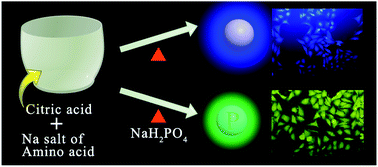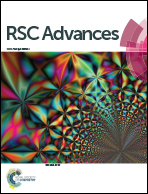Amino acid functionalized blue and phosphorous-doped green fluorescent carbon dots as bioimaging probe†
Abstract
Amino acid functionalized carbon dots (CDs) were synthesized in a simple and cost effective bottom up approach. Citric acid was used as the source of the carbon core and three amino acids L-isoleucine, L-valine and glycine were used for the surface fabrication of CDs to produce CDiso, CDval and CDgly, respectively. Interestingly these CDs were found to fluoresce with a blue emission. Doping of phosphorus to these CDs (PCDs) tuned the photoemission properties and produced green emitting PCDs. The doping of phosphorous (P) to these CDs improved their fluorescence intensity as well as quantum yields. Both doped and non-doped CDs were characterized by spectroscopic and microscopic techniques. These highly stable CDs were biocompatible in nature and did not exhibit any photobleaching property over a long span of time even under UV exposure. Subsequently, these CDs were exploited as an excellent bioimaging probe. Importantly CDs and PCDs illuminated cells in two completely different spectral regions blue and green, respectively in accordance with their fluorescence spectral behaviour. Hence, amino acid functionalized carbon dots based bioimaging probes with different fluorescence characteristics were developed that are widely applicable for cellular imaging in both blue and green spectral regions.


 Please wait while we load your content...
Please wait while we load your content...